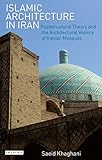Islamic architecture in Iran : poststructural theory and the architectural history of Iranian Mosques / Saeid Khaghani.
Series: International library of Iranian studies ; 34.Publication details: London ; New York : I.B. Tauris ; New York : Distributed in the United States and Canada exclusively by Palgrave Macmillan, 2012.Description: x, 245 p. : ill. ; 24 cmISBN:- 9781848857292 (hbk.)
- 1848857292 (hbk.)
| Item type | Current library | Home library | Collection | Call number | Materials specified | Copy number | Status | Date due | Barcode | |
|---|---|---|---|---|---|---|---|---|---|---|
| AM | PERPUSTAKAAN TUN SERI LANANG | PERPUSTAKAAN TUN SERI LANANG KOLEKSI ISLAM-P. TUN SERI LANANG (ARAS 4) | - | NA1483.K483 ki (Browse shelf(Opens below)) | 1 | Available | 00002090303 |
Introduction -- Islam as an Attribution -- Iranism -- The Mosque as Public Space -- Difference and the Iranian Architectural Discourse -- Difference and Particularity -- Conclusion.
'The architecture of the Islamic world is predominantly considered in terms of a dual division between'tradition' and'modernity' - a division which, Saeid Khaghani here argues, has shaped and limited the narrative applied to this architecture. Khaghani introduces and reconsiders the mosques of eighth- to fifteenth-century Iran in terms of poststructural theory and developments in historiography in order to develop a brand new dialectical framework. Using the examples of mosques such as the Friday Mosques in Isfahan and Yazd as well as the Imam mosque in Isfahan, Khaghani presents a new way of thinking about and discussing Islamic architecture, making this valuable reading for all interested in the study of the art, architecture, and material culture of the Islamic world.'--Publisher.
There are no comments on this title.

